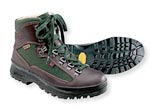Two words: Bell curve. Human feet fall along that curve ranging from super-narrow to super-wide. Most of us scatter around the middle. And, not surprisingly, so do shoe and boot makers. If you’ve got a foot that’s similar to what one percent of the population has, it’s difficult for them to cater to you for obvious reasons of cost per shoe.

Still, another size in the Cresta may work. Those boots come in three widths, and the last they’re built upon seems exceedingly well designed, meaning it “fits” a pretty broad swath of people. So with luck that will work.
Otherwise, all those things that you apparently don’t want to fool with聴insoles, thick socks, lacing techniques聴are your next-to-last resort. Insoles in particular can make a big difference. I think just about everyone should swap out the factory insoles, which really are pretty lousy even in expensive boots, and install an after-market one such as Superfeet ($30; www.rei.com). The Superfeet people make a “high profile” that’s designed to soak up extra space. And, no harm in wearing some extra socks聴I used to do that on a regular basis before I started to find boots that fit. You can also lace the boots in various ways to tighten them in one direction or another. You’ll need to find a really good boot-fitter for that, though.
Otherwise, your choices are to buy custom boots or customize stock boots. Custom boots include Limmer boots, though these will set you back $560 and take a patience-enhancing 42 months to land on your doorstep. A lot of dough and a long wait, but a lifetime investment, too. You may also be able to modify existing boots, particularly in the heel area. A good boot repair person, such as Dave Page in Seattle, could take a pair of leather-lined boots, disassemble them, and add additional or thicker leather to the heel area.
So there you go. Hope you find something that works!


